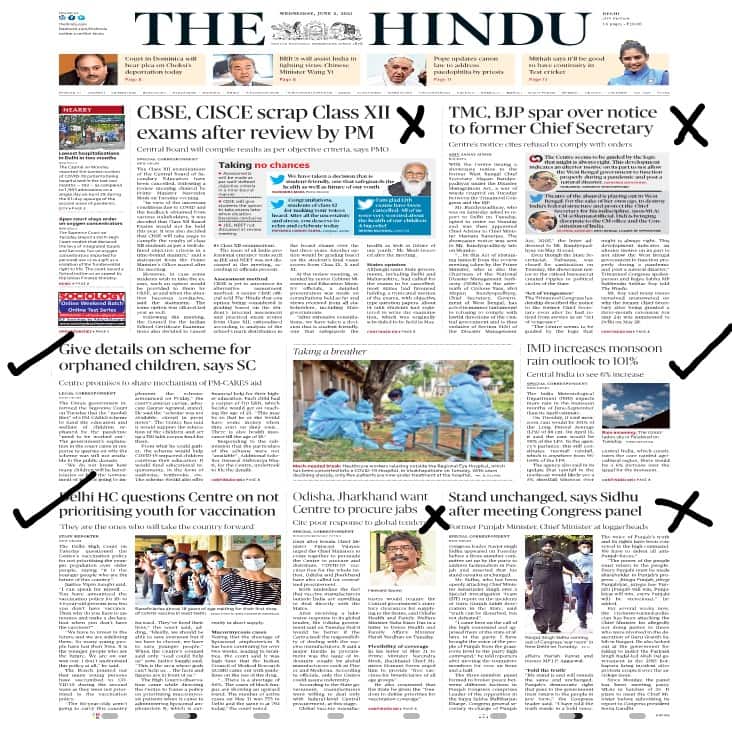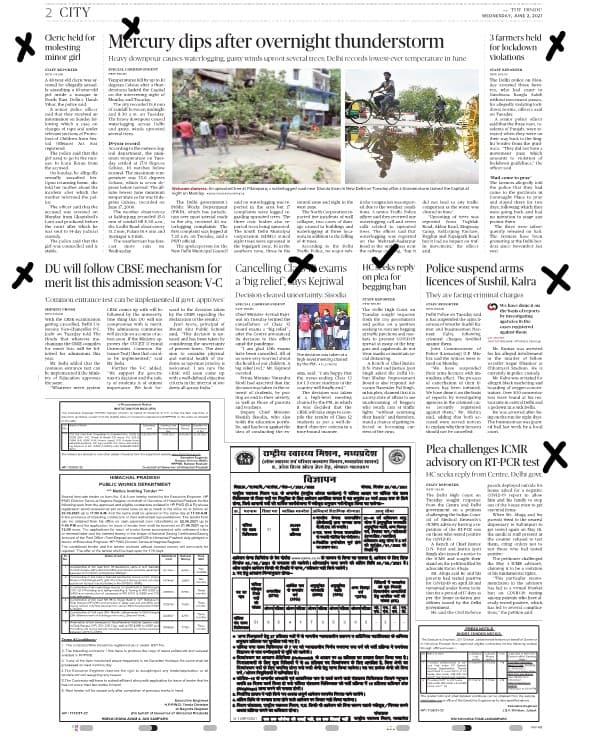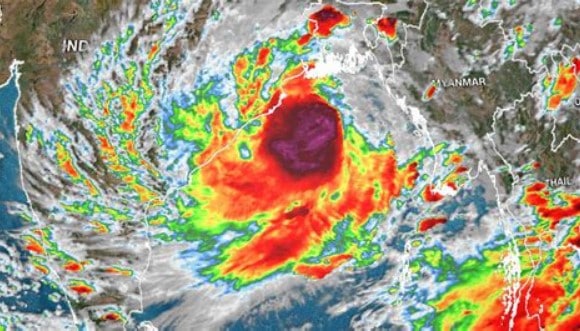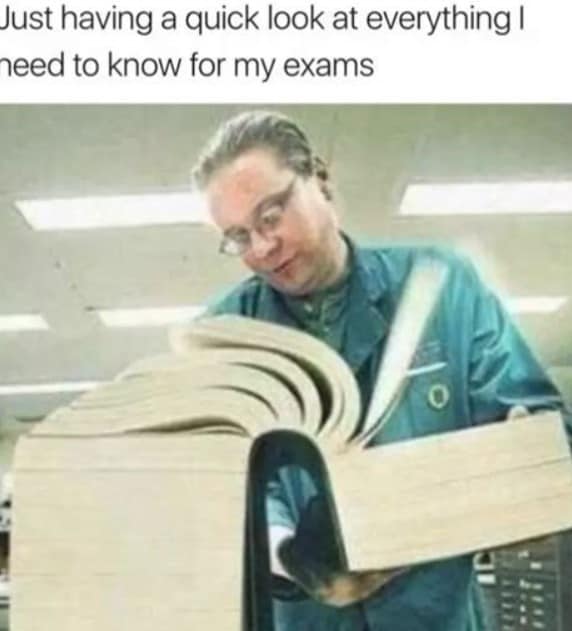Reading the newspaper for UPSC are ubiquitous with IAS exam preparation. But how exactly to cover newspapers scientifically from the POV of the UPSC exam is far less understood.
Questions abound- When to start reading newspaper for UPSC ? How many to be read ? What exactly to read ?How to make notes ? How much time should be invested ?How to revise ?

Fear not, I had the same doubts when I started UPSC preparation. In this article, I share my insights about how to do so with maximum efficiency.
1. When to start reading newspaper for UPSC ?
The pattern of questions being asked in UPSC Prelims requires coverage of around 1.5 years worth of current affairs. To do so extensively requires a commitment of extracting relevant current affairs from the newspaper consistently for an year or more. But if done correctly, this might be the best investment an aspirant could make.
This is because most of the terms you will encounter in the newspaper will be new to you. But highly pertinent to the UPSC exam. Take for example Current affairs from the economics section.
Consider a recently published editorial which explains the surge in FDI inflows.

The editorial contains terms like gross inflow ,direct investment ,repatriation/disinvestment, greenfield investment, Net portfolio Investment, FII ,FDI , short- term investment, domestic capital market ,equity, debt etc.
Here’s what you should do :
1. Highlight all such terms in your first reading. Try to grasp what you can from the article even if that means you do not understand it fully.
2. After your first glance, google each of the terms you highlighted but do not spend more than a few minutes for each search. Your search for these keywords should allow for a broad conceptual understanding of these terms and need not be technically complex.
3. Then without lingering, do a second reading of the editorial to make sense of it with the terms you have been exploring and notice how the meaning changes.
4. The entire process should not exceed 90 minutes/day.
As you repeat this process daily, not only will you be covering a host of different topics comprehensively but also increasing your knowledge network exponentially as you go.
2. How many newspapers to read for UPSC ?
It goes without saying that the news remains the same whether it’s the Hindu or Economic Times. (I personally feel TOI is more a gossip newspaper and not much relevant for UPSC ) .
My personal favorite is The Hindu – it’s a balanced newspaper and contains a lot of relevant UPSC relevant news. The editorials are easy to comprehend and written by a variety of experts which gives you a rich analysis which is required for UPSC Mains answer- writing.

Regardless of my preferences, chose any one newspaper and follow it .Don’t procrastinate or else there may soon be a huge backlog which becomes impossible to cover.
3. What to read from the newspaper?
More appropriately, what NOT to read in the newspaper. This is because not everything written in a newspaper is worth spending time over. You will have to filter the newspaper for useful info and skip the rest.
Here is a 5-layer filter to apply:
1. Should not be a political piece.
2. Should be able to fit into one of the broad topics of GS syllabus like Polity, Economics, Geography etc.
3. World news where India does not has any role to play can be skipped
4. Most of the state news can be skipped except those announcing government schemes or similar issues.
5. All celebrity news, page 3 content and other fashion industry related news should be skipped.
5-layer filter
Here is a snapshot of my filtering on a newspaper.

Note the pattern of choosing the pieces worth reading-

Example : The ongoing Israel Palestine issue. You need not try to get into everyday developments of the conflict. It will waste your time. You should have a broad overview of the reasons for the conflict and wait for any important decision or outcome of the conflict. Only then should you analyze the entire conflict carefully and critically.

Example : Yaas cyclone :Even though it was in the news continuously for 10 days, as an aspirant, all you needed to know was the type of cyclone ,its origin , disaster management efforts being done etc.
4.How to make notes from the newspaper ?
Notes making can be a tough task especially for newbies as they are not able to understand what is important and what is not leaving them overwhelmed.

Here are 5 simple guidelines to keep in mind while making notes from the newspaper for UPSC-
1.Notes should be short and Crisp.
2. Points that can be common to other issues also should be noted
3. Make notes for recurring themes like federalism ,judicial activism ,best practices for pandemic management ,best practices for cyclone relief and rescue.
4.Make notes GS Paper wise and for factual information for prelims keep a separate folder.
5.Last but not the least ,make note which YOU can revise at the end (Taking notes of others never helps )
As an example, consider this piece about Child labor in India-

Notes for the above article –
Impact of pandemic unknown but it will be significant as children are unable to attend school and parents are unable to find work. However, not all the factors that contribute to child labour were created by the pandemic; most of them were pre-existing and have been exposed or amplified by it.
95% of the children in the age group of 6-13 years are attending educational institutions (formal and informal) while the corresponding figures for those in the age group of 14-17 years is 79.6%. Hence, a large number of children in India remain vulnerable, facing physical and psychological risks to a healthy development .
UNESCO estimates based on the 2011 Census record 38.1 million children as “out of school” (18.3% of total children in the age group of 6-13 years).
Work performed may not appear to be immediately dangerous, but it may produce long-term and devastating consequences for their education, their skills acquisition, and hence their future possibilities to overcome the vicious circle of poverty, incomplete education and poor quality jobs.
Less than half of children in the age group of 10-14 years have completed primary education. These remain challenges we must overcome.
Child labor in India decreased in the decade 2001 to 2011.
Concerns :
Risk of back- tracking the gains made in eliminating child labour.
With increased economic insecurity,
lack of social protection ,
reduced household income,
children from poor households are being pushed to contribute to the family income with the risk of exposure to exploitative work
Efforts by government :
(MGNREGA) 2005,
RTE Act 2009
Mid Day Meal Scheme
have paved the way for children to be in schools along with guaranteed wage employment (unskilled) for rural families. Concerted efforts towards convergence of government schemes is also the focus of the implementation of the National Child Labour Project.
Ratifying International Labour Organization Conventions Nos. 138 and 182 in 2017, the Indian government further demonstrated its commitment to the elimination of child labour including those engaged in hazardous occupations.
The Ministry of Labour and Employment operated online portal (www.pencil.gov.in) allows government officials, law enforcement agencies and non-governmental organizations to share information and coordinate on child labour cases at the national, State and local levels for effective enforcement of child labour laws.
Challenges in education :
With closure of schools and challenges of distance learning, children may drop out
As many schools and educational institutions are moving to online platforms for continuation of learning, the ‘digital divide’ is a challenge that India has to reconcile within the next several years
24% of Indian households had access to an Inter- net facility, proportions were 15% among rural households and 42% among urban households.
ASER) 2020 survey highlights that a third of the total enrolled children received some kind of learning materials from their teachers during the reference period (October 2020) as digital mode of education was opted for.
Way Forward :
Right level of commitment among all the relevant stakeholders and the right mix of policy and programmatic interventions, strategic partnerships and collaborations involving government, employers, trade unions, community-based organizations and child labour families will help us to build back better and sooner .
-Notes by Nitisha Gupta, IRS from the newspaper for UPSC
Consider another example about China’s recent Third Child Policy-

Notes for the above article –
1.Six years after abandoning the “one child policy” of 1979, China’s Communist Party has now introduced a “three child policy”. The move is to “improve China’s population structure, actively respond to the ageing population, and preserve the country’s human resource advantages”,
2.In the latest census they have found that birth rates have reduced ,fertility rate already had dropped earlier .
3.Yet, the urgency of recent measures suggests otherwise, as China grapples with both an ageing and deeply gender-imbalanced population, and demographers’ worst fears of countries getting old before they get rich .
4.In 2013, China allowed couples to have a second child if either parent was an only child, with the two child policy introduced in 2015.
5.The two child policy “substantially increase[d] the number of second-child births” among those “less sensitive to child-rearing costs” but “substantially decrease[d] the number of first-child births” attributing it to rising costs.
6.Policy makers should give priority to reducing the child-rearing costs borne by prospective parents rather than simply relaxing or even abolishing birth quotas”
7.China’s experience is a reminder of the unintended social and economic consequences of state-led demographic interventions.
-Notes by Nitisha Gupta, IRS from the newspaper for UPSC
5.How much time should be invested in reading newspaper ?
Time is the most valuable resource in this preparation. If you are out in one of the three stages, an entire year may be wasted along with draining you financially and emotionally.

It is a misconception that your time-consumption will remain constant all through the preparation. Do not be afraid if takes long hours during the beginning. As you get better at reading the newspaper for UPSC, your time-consumption will decrease. Initially, when you are just starting it may take around 4-5 hours (including notes making) but try to reduce it to two hours by a month. After 3-4 months ,it should take only 1.5hours maximum.
6.How to revise notes and clippings from the newspaper ?
Once you have acquired all the necessary knowledge, the key to qualify the exam is Revision ,Revision and Revision.
The syllabus of UPSC is vast and varied from polity to economy to geography to history and much more .So it is natural that there will be a mixture of all the news and information .For the examination you need to train your brain.
Our brain has to be compartmentalized and information should be stored in these compartments just like you store your clothes in the wardrobe .The only option to avoid the scenario depicted in the image below is to do periodic revisions.

Ideally, once every month. fix the last 6 days for revising whatever you have read in the previous month and refresh your information .
This will also help you to revise each and every subject instead of just revising one. Ultimately ,if you do not reproduce the information in the exam the time you invested to gather that information will be wasted .
I hope this has been helpful!
Tc and all the best,
– By Ravi Kapoor, IRS & Nitisha Gupta, IRS
Find me on Qoura
Youtube : Ask the topper channel

I read daily newspaper. Also, there are many AI tools which can help you to read newspapers
That way to very nice to preparation of UPSC exam and you have also explained very well
Thanks you sir for this and article ?
Thank you so much, this session provide more clarity about reading newspaper and preparing notes
Thank you sir for this wonderful session and also thank you Nitisha mam for enlightened me ..This session is an eye opener about current affairs
i learned a lot and now i am going to fly.
Thank u sir giving me clear idea for analysing newspaper
India leading with 5.5% women representation in world democracies
India has witnessed a burgeoning movement for gender inclusivity during the past few years. The Supreme Court judgment national legal service authority vs union of india 2014 on gender identity has given the movement greater impetus.
After 75 years of independence and azadi ka amrit mahotsav , Parliament often refers to women in leadership positions as chairmen and party men.
Gender neutral acts have made references to women not as leaders or professionals, but usually as victim of crimes.
The root of such instances lies with a gender conforming constitution
This session gives me complete idea of categorize news which is relevant for the exam and understood importance of editorials in essays. Am using magazines for preparation of current affairs, lacked confidence in reading newspaper and preparation of notes . and now my whole mentality of analyzing and reading of newspaper changed.thank u so much sir
Thank you sir for clearing doubts. Your task helps me in encouraging myself toward preparation.
Date : 31.03.2022
News Head : Govt to reduce the disturbed area under under Armed Forces Special Power Act (AFSPA) in Nagaland, Assam, Mainpur
AFSPA :
1. AFSPA 1958 is an act of Parliament that grant special powers to Indian Armed Forces to maintain public order in disturbed areas.
2. It was first promulgated by British Colonial Govt to suppress the Quit INDIA Movement.
3. According to the Disturbed Area Act 1976 once declared DISTURBTED the area has to maintain status for a minimum 6 months.
Power given under AFSPA :
1. Any suspect can be arrest without a warrant
2. Armed forces can search any house without any warrant
3. Any vehicle can be stopped and searched
4. Prohibit gathering of five or more persons in an area
2.I already made a separate notebook for Current affairs, but video gives me a lot information about to tackle CA (Current affairs) easily and more efficient way. And by this It also helps in making sense what to study. And how to gather info more easily and making of their records also. Thank you sir.
Thank you sir for clearing doubts. Your task helps me in encouraging myself toward preparation.
Date : 31.03.2022
News Head : Govt to reduce the disturbed area under under Armed Forces Special Power Act (AFSPA) in Nagaland, Assam, Mainpur
AFSPA :
1. AFSPA 1958 is an act of Parliament that grant special powers to Indian Armed Forces to maintain public order in disturbed areas.
2. It was first promulgated by British Colonial Govt to suppress the Quit INDIA Movement.
3. According to the Disturbed Area Act 1976 once declared DISTURBTED the area has to maintain status for a minimum 6 months.
Power given under AFSPA :
1. Any suspect can be arrest without a warrant
2. Armed forces can search any house without any warrant
3. Any vehicle can be stopped and searched
4. Prohibit gathering of five or more persons in an area
thankyou this session helps a lot and teach me to not waste all the time in reading newspaper
Based on The Hindu Editorial
” The many problems of online anonymity”
Security researchers identify anonymity as being ‘unidentifiable within a set of objects.’ Usage of Pseudonyms are the most common form of anonymity on social media.
Anonymity can be either by choice or enforced by platforms like Glassdoor, wherein anonymous reviews are the norm.
Reason behind anonymity:
1. To be able to speak the truth against vindictive government.
2. To actively participate in online conversations without the fear of judgement.
3. To ensure zero impact on their real-world selves.
Concerns:
1. Less inhibited and bold views can be expressed on issues, hence higher chance of abuse or extreme opinions.
2. Sharing fake news- misinformation and disinformation.
Anonymity in social media allows the person to escape the judgement by public opinion.
If the need arises, the only action that can be taken is legal in nature.
Insights:
The issues can always be traced back to certain static concepts.
Editorials provide a better understanding into issues.
This method is used to compartmentalize the various aspects of issues clearly.
1 states weigh options on ias cadre rule changes…the union govt is planning to acquire for itself overriding powers to transfer ias n ips officer through central deputation dopt wrote to state to amend rule 6 [deputation of cadre officers] of ias rules1954. No State Control which is conflict between democracy and beaurocracy n conflict of federalism.Pros: will give scope to unwanted development.Cons: spirit of cooperative federalism.
2 celestial flybys – an asteroid 7482[1994pc1] flew past the earth on Jan 18.potentially hazardous from NASA alert
3 problems of online anonymity: pseudonymous social media handles and platforms that encourage them amplify issues around fake news.ethics point of view is question on human integrity
4 swamp deer extinct- Kaziranga np,tr extinct due to 2 high floods
5 miss kerala- Dennison barb]native fresh water fish species found in Karnataka n Kerala.Also has been added in schedule 1 of wlp amendment bill,2021.
Jai Hind, thankyou so much for your support. Now I am not afraid of any kind of thing or question which are coming in my mind, you have cleared so many doubts of mine. Thankyou so much again, Your guidance are very effective to me. It boost up my courage towards my studies. Thankyou so much.